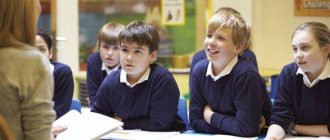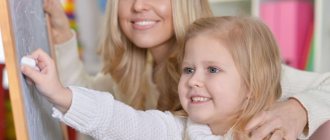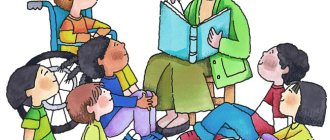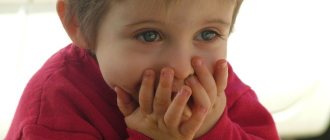Introduction
Purpose of the work: To characterize the general concept of ODD, its levels, statistics, symptoms, analyze the basic concepts of the work, consider the progress of speech therapy examination of children with ODD.
Relevance of the topic: Speech for a person is the most important factor in his development and socialization. With the help of speech, we exchange information and interact with each other. But there are many people who suffer from speech disorders. There are many reasons for the occurrence of such defects: the influence of ecology, heredity, unhealthy lifestyle of parents, pedagogical neglect. And people with such problems need the help of specialists.
This problem (speech impairment) arises already in preschool age, and this stage of life requires special study, analysis and special attention from both practitioners and scientists. A child with general underdevelopment, regardless of the level of speech development, first of all faces a violation of all components of speech - this is the sound culture of speech, the grammatical structure of speech, passive and active vocabulary and coherent speech, and the specialist does not create the necessary conditions to correct this defect.
Degree of development of the problem: In science, domestic scientists (R.E. Levina, N.A. Nikanshena, G.A. Kashe, L.F. Spirova, G.I. Zharenkova) have been studying the problems of correcting general underdevelopment of speech for a long time, but the remedies are not differentiated depending on the level of speech development and need to be improved, which is why this problem was chosen for special study.
Methods and techniques for working on speech development with children ONR material on correctional pedagogy
“Methods and techniques for working with children with special needs speech development”
Prepared by: Prosekova T.G.
The Federal State Educational Standard (FSES), which entered into force in January 2014, sets us the task of protecting and strengthening the physical and mental health of children; development of individual abilities and creative potential of each child; development of their moral, intellectual, physical, aesthetic qualities, initiative, independence; formation of prerequisites for educational activities. In this regard, the search for effective methods and techniques aimed at correcting speech disorders in preschool children with speech underdevelopment is becoming increasingly popular.
General speech underdevelopment is a speech pathology in which there is a persistent lag in the formation of all components of the language system: phonetics, vocabulary and grammar.
An indispensable condition for the comprehensive development of a child and for his successful education at school is the ability to communicate with adults and peers. Children with ODD are characterized by a low level of development of the basic properties of attention. Some of them have insufficient stability of attention and limited possibilities for its distribution.
Speech retardation has a negative impact on the development of memory in such children, as compared to normally speaking children, memory and memorization productivity are noticeably reduced.
Children with OHP have features in the formation of small
hand motor skills This manifests itself, first of all, in insufficient coordination of the fingers.
Teaching storytelling as a method of forming coherent speech in children with special needs is one of the most pressing, but still not fully explored problems.
Coherent speech is not just a sequence of words and sentences - it is a sequence of interconnected thoughts that are expressed in precise words in correctly constructed sentences.
Every child must learn to express their thoughts meaningfully, grammatically correct, coherently and consistently. At the same time, children’s speech should be lively, spontaneous, expressive
The success of children's education at school largely depends on their level of mastery of coherent speech. Perception and reproduction of textual educational materials, the ability to give detailed answers to questions, independently express one’s opinions - all these and other educational activities require a sufficient level of development of coherent speech.
The ability to talk helps a child to be sociable, overcome silence and shyness, and develop self-confidence. Coherent speech is understood as a detailed presentation of certain content, which is carried out logically, consistently and accurately, grammatically correct and figuratively.
The concept of “coherent speech” refers to both dialogic and monologue forms of speech. Each of them has its own characteristics.
The form of dialogical speech encourages incomplete, monosyllabic answers. Incomplete sentence, exclamation, interjection, bright intonation expressiveness, gesture, facial expressions, etc. – the main features of dialogical speech. For dialogical speech, it is especially important to be able to formulate and ask a question, construct an answer in accordance with the question asked, give the necessary remark, supplement and correct the interlocutor, reason, argue, and more or less motivatedly defend one’s opinion.
Monologue speech as the speech of one person requires detailedness, completeness, clarity and interconnection of individual parts of the narrative.
A monologue, a story, an explanation require the ability to focus your thoughts on the main thing, not get carried away by details and at the same time speak emotionally, vividly, figuratively.
Teaching storytelling as a method of forming coherent speech in children with special needs development
Retelling training
When teaching retelling to children with special needs, auxiliary methodological techniques are used to make it easier to compose a coherent, sequential message, which is especially important in the initial stages of work. In the first year of study, they master the skills of reproducing text based on illustrative material and the help of a teacher. Facilitating techniques include highlighting the main meaningful links of the plot of the work during the compilation of the retelling (retelling on key issues, showing illustrations that consistently reflect the content of the work, and later - individual illustrations depicting characters and significant details). Initially, children retell one fragment of text at a time; Subsequently, they gradually move on to an individual retelling of several fragments and the text as a whole. By the end of the first year (III period of study), they learn to compose a retelling according to a preliminary plan-scheme. Supporting questions for the text are given in the form of a detailed verbal plan before the retelling begins. In the second year of study, children should master retelling without relying on visual material,
An effective technique for teaching retelling is the use of children's drawings. When teaching retelling, in some cases it is advisable to use an “illustrative panel” with a colorful depiction of the situation and the main details with which the development of the plot action of the work is connected. The listed methodological techniques are simple and accessible for practice in working with children with special needs. During retelling classes, special attention is paid to correctional work on developing grammatically correct speech in the child and mastering various linguistic means of constructing coherent statements.
Retelling classes include: exercises in inflection, selection of lexemes and word forms; exercises in supplementing a sentence with the right word, reproducing specific lexical material of the text in the form of a game-exercise “Who remembered better?” etc. Thus, children develop skills of practical actions with the linguistic material of the retold works.
Work on the development of phrasal speech in retelling classes includes:
— mastering the normative principles of constructing phrases of various syntactic structures; exercises in the correct use of phrases based on the linguistic material of literary works, followed by the use of acquired skills when independently compiling a retelling;
- development of attention to the syntax of language, the ability to notice errors in the construction of phrases in the stories of other children and errors in one’s own statements.
2. Learning to tell stories from pictures
Teaching storytelling from pictures occupies an important place in the overall correctional work on the development of coherent, grammatically correct speech of children with SLD. The teaching methodology is based on the speech disorders observed in such children and the characteristics of mental and cognitive development. This concerns the conduct of special preparatory work, the selection and sequence of use of painting material, the structure of classes and methods of correctional work. Attention is paid to techniques aimed at developing attention, visual and auditory perception, logical thinking, etc.
In order to form a coherent monologue speech of older preschoolers with SLD, it is recommended to conduct the following types of classes with picture material:
Compilation of short stories-descriptions based on plot paintings, in which the foreground is the image of the scene, objects, events that determine the theme of the paintings (“Ice drift”, “The river is frozen”, etc. from the thematic series of O.I. Solovyova, V.A. Ezikeeva, etc.).
3. Narration through a series of plot pictures that depict in sufficient detail the development of the plot action. A series of pictures based on stories by N. Radlov (“Umbrella”, “Tiger and Bunnies”, etc.), V.G. can be used. Suteev (the “Nakhodka” series, etc.), painting material by V.V. Gerbova. In the second year of study, it is recommended to complicate the tasks. (Series of pictures “Smart Hedgehog”, “Bunny and Ducks” - based on stories by N. Radlov and others.)
4. Teaching storytelling based on a separate plot picture with children inventing previous and subsequent events (based on supporting questions). For this purpose, you can use the pictures “Saving the ball”, “The ball flew away”, etc.
5. Description of the landscape painting.
Correctional and speech therapy work on the formation of different aspects of children's speech in classes based on paintings includes the formation of grammatically correct speech, the development of phrasal speech, enrichment of the vocabulary and is carried out taking into account the characteristics of specific picture material in accordance with the objectives of each period of training.
6. Learning to describe objects
Description is a special type of coherent monologue speech. The communicative task of a description statement is to create a verbal image of an object, the characteristics of which are revealed in a certain sequence.
Classes on teaching description have a diverse impact on the cognitive development of children and the formation of their speech-thinking activity, contribute to the activation of visual, speech-auditory and tactile perception, memory, attention, and observation. In the process of description, they learn to identify and compare the essential features of an object, to combine individual statements into a coherent, sequential vocative message.
7. Teaching storytelling with elements of creativity
Creative stories are understood as stories invented by children with an independent choice of content (situations, actions, images), a logically constructed plot, expressed in an appropriate verbal form. Methodological developments were given by A. M. Borodich, L. P. Fedorenko, G. A. Fomicheva, A. P. Nikolaicheva, E. I. Tikheeva.
Teaching creative storytelling plays a crucial role in the development of verbal and logical thinking, providing great opportunities for the child to independently express his thoughts, consciously reflect in speech various connections and relationships between objects and phenomena, and contributes to the activation of knowledge and ideas about the environment. Creative storytelling brings the preschool child as close as possible to the level of monologue speech that he will need to transition to a new leading (learning) activity. Its main types include stories by analogy, inventing the continuation and completion of the story, composing it using several key words and on a proposed topic.
Innovative methods of influence are becoming a promising means of correctional and developmental work with children with special needs. These methods are among the effective means of correction and help achieve the maximum possible success in overcoming speech difficulties in preschool children. In our practical activities we use the following innovative methods.
One of the most effective methods in correctional work is the development of interhemispheric interaction, which is called kinesiology. This is the science of developing mental abilities and physical health through specific motor exercises. Kinesiology pays special attention to exercises that use simultaneous different types of hand movements. The regulation of such movements is carried out at the level of the brain, in contrast to symmetrical conjugate movements, the regulation of which mainly occurs at the level of the spinal cord. Kinesiological exercises can be used both in the correctional and developmental classes themselves, as dynamic pauses (rest breaks, and before classes as an organizing link that sets up the child’s body for fruitful work during classes. In our work we use exercises such as: “Fist - rib - palm", "Lezginka", "Mirror drawing", "Ear - nose", "Snake". For example: "Bunny - ring" The exercise is based on moving from this position to another: a) fingers - into a fist, extend the index and middle fingers and spread them apart; b) connect the thumb and index fingers into a ring, spread the remaining fingers apart.
The bunny jumped from the porch and found a ring in the grass.
And the ring is not simple - it shines like gold.
Widely using kinesiology techniques in our practice, we noticed that children-speech therapists had significantly improved hand-eye coordination, improved memory, attention, speech, fine and gross motor skills, decreased fatigue, and lost excessive tension.
Su-jok therapy is highly effective, safe and simple. The use of su-jok massagers “Miracle Roller”, massage balls complete with metal rings simultaneously with exercises for correcting sound pronunciation and developing lexical and grammatical categories helps to increase physical and mental performance, creates the basis for a quick transition to a higher level of motor activity of the muscles and an opportunity for optimal targeted speech work with the child. Su-jokis are also used to automate corrected sounds. For example, rolling the massager between his palms, the child recites a poem to automate the sound [zh]:
The hedgehog walks without paths, does not run from anyone
A hedgehog covered in needles from head to toe. How to take it?
Sujok therapy is carried out in stages.
Stage I. Introducing children to su-jok, the rules of its use through oral folk art, poetry, riddles, and fairy tales.
Stage II. Consolidation of knowledge in exercises and games.
Stage III. Independent use of the su-jok ball in accordance with your needs and desires.
Speech therapy rhythm is one of the effective means of corrective influence on the education of children with speech pathology. Logorhythmics is used for children to master various movements, which are not only general strengthening, but also corrective and developmental; promotes the development of speech breathing, articulatory motor skills, strengthening of facial muscles, the formation of a phonemic system, the development of tempo-rhythmic and melodic-intonation characteristics of speech, coordination of movement and speech. In their work, speech therapists use either individual exercises and games, or conduct a complex logorhythmic lesson.
Separate exercises and games: “Where? "(work on intonation).
Where? (sharply up) Stop! (Stop! - spin).
Where? Where? Come back! (demanding hand gesture towards yourself).
Don't you dare run away! (natural movement).
“Let's talk together” (work on speech tempo)
I walk up the stairs quietly.
I quickly run down the stairs.
(Children imagine climbing up the stairs, showing movements in place, raising their legs high, bent at the knees. They quickly run in a circle).
Thus, innovative methods of influence in activities are becoming a promising means of correctional and developmental work with children with special needs. These methods are among the effective means of correction and help achieve the maximum possible success in overcoming speech difficulties in preschool children. Against the backdrop of comprehensive speech therapy assistance, innovative methods, without requiring much effort, optimize the process of correcting children’s speech and contribute to the healing of the entire body.
Basic concepts of speech and its components
The term speech is understood as a historically established form of communication between people through linguistic structures created on the basis of certain rules. The process of speech involves, on the one hand, the formation and formulation of thoughts by linguistic (speech) means, and on the other hand, the perception of linguistic structures and their understanding.
The development of children's speech begins from the very first days. By development we mean a directed, natural change in a phenomenon or process, leading to the emergence of a new quality.
By components of the speech system we mean:
- phonemic hearing,
- sound pronunciation,
- dictionary,
- grammatical structure of speech,
- rhythmic-syllable structure of speech,
- coherent speech.
Each component of this system is an important link in the structure of speech.
So phonemic hearing is a person’s ability to analyze and synthesize speech sounds, the correct pronunciation of which contributes to the formation of a person’s communicative abilities.
Sound pronunciation is the process of formation of speech sounds, carried out by the energetic (respiratory), generator (voice-producing) and resonator (sound-producing) departments of the speech apparatus under regulation by the central nervous system.
The rhythmic-syllable structure of a word is the correct sequence of sounds and syllables in a word.
Full development of speech is impossible without a sufficiently rich vocabulary (active and passive). An active dictionary is a set of words that a child uses when constructing statements. A passive dictionary is a set of words that a child understands but does not use in speech.
The grammatical structure of speech plays a certain role - this is the structure of words and sentences inherent in a given language, without which the existence of the following speech system - coherent speech - is impossible.
Coherent speech is a statement that presupposes the presence of a certain internal (semantic) and external (linguistic), constructive (structural) connection of its individual parts.
Thus, all components of the language system are interconnected and complement each other, and distortion or insufficient development of one of them determines a speech defect.
For example, insufficient development of the grammatical structure of speech entails agrammatisms - a violation of the psychophysiological processes that ensure the grammatical orderliness of speech activity. [3]
Article:
In the development of a child, all cognitive processes are interconnected.
And disturbances that occur in one of them will certainly have an impact on other processes. Speech is one of the most important cognitive processes, the development of which affects a person’s relationship with the outside world, and therefore the very development of a person’s personality. Therefore, understanding the specifics of working with children with general speech underdevelopment is necessary. “General speech underdevelopment is various complex speech disorders in which children have impaired formation of all components of the speech system related to its sound and semantic side, with normal hearing and intelligence . At the same time, the general underdevelopment of speech is systemic in nature, that is, in the child’s speech there is a violation of the development of all aspects of speech: lexical. grammatical, syntactic, pronunciation. General underdevelopment of speech is considered to be an external manifestation of such diagnoses as: dysarthria, rhinolalia, stuttering, alalia, hearing impairment, decreased intelligence, and insufficient phonemic hearing.
The following levels of general speech underdevelopment are distinguished:
OHP level 1. The child has practically no speech. The active vocabulary is poor. When forming speech utterances, the child uses mainly babbling words, the first syllables, and onomatopoeia. The child actively uses gestures and facial expressions, understands speech addressed to him (rich passive vocabulary). A child with the first level of general speech underdevelopment has his own specific “language” of communication with the outside world.
OHP level 2. The child uses a certain limited number of words in his speech. Poor active vocabulary, words are pronounced in a distorted form. Does not know how to combine objects into a group, does not know the basic characteristics of objects, can pronounce simple words depending on their number, there is no agreement between words in simple sentences. The child can compose a coherent story, but mostly uses two-syllable, inconsistent sentences consisting of a subject and a predicate.
OHP level 3. General underdevelopment of speech is manifested in a lag in the grammatical and phonemic development of speech. Large active and passive vocabulary, the child uses detailed phrases, active expressive speech. Unclear pronunciation of sounds, often replacing more complex sounds with simple ones. Whistling, hissing, sonorant and affricates are the most difficult sounds to pronounce. The child finds it difficult to grammatically coordinate words, especially nouns with numerals. Can compose a story that contains a certain sequence of actions.
OHP level 4. The sound pronunciation is correct, but the articulation is incorrect, which means the speech is slurred. Sometimes the child skips syllables in words, rearranges them or replaces sounds. Difficulties in using words denoting the characteristics of an object. The process of word formation is also difficult, especially with the help of suffixes. Agreements between words in a sentence, especially nouns and adjectives, are difficult.
Children with general speech underdevelopment are also characterized by insufficient development of processes closely related to speech activity, namely: attention and memory are impaired; impaired finger and articulatory motor skills; verbal and logical thinking is insufficiently formed. Since speech and thinking are closely related, the verbal and logical thinking of children with speech underdevelopment is below the age norm. General underdevelopment of speech also affects the behavior and well-being of the child. Therefore, it is necessary to instill in such children the norms of communication in a team, without which full-fledged education and upbringing is impossible. It is necessary to monitor the pronunciation side of speech, and, if necessary, correct the child’s speech correctly and tactfully. it is necessary to pay special attention to improving the articulatory apparatus and fine motor skills, since its development is directly related to the mental, and therefore speech, development of the child. Carrying out work to consolidate children’s speech skills and constantly replenish children’s vocabulary. A special role in the development of a child is played by classes in design, modeling, appliqué, and drawing. When conducting individual lessons, the child’s attention is focused on words and sounds that cause particular difficulties. All speech development tasks for children with special needs must be supported by visual material. That is why individual lessons with children are recommended to be carried out in various rooms of the kindergarten. During walks, you can draw the attention of a child with OHP to compare the signs and properties of the living and inanimate objects around him. Working with parents is no less important, since the family is the primary socializer of the child. You can unobtrusively and delicately recommend to parents certain exercises, tasks, games that would contribute to the development of their child. Thus, the features of working with preschool children with ODD consist in the coordinated work of the teacher, speech therapist, educational psychologist and the child’s parents, in special attention to the issue of development of the pronunciation side of speech, which consists of continuous, daily, systematic work on the development of the pronunciation side of speech child, replenishing his vocabulary.
General characteristics of speech underdevelopment
For the first time, the theoretical basis for ONR was formulated as a result of multidimensional studies of various forms of speech pathology in children of preschool and school age conducted. R.E. Levina (1961) and a team of researchers from the Research Institute of Defectology (N.A. Nikashina, G.A. Kashe, L.F. Spirova, G.I. Zharenkov, etc.) in the 50s – 60s of the 20th century. Deviations in the formation of speech began to be considered as developmental disorders that occur according to the laws of the hierarchical structure of higher mental functions. From the standpoint of a systems approach, the question of the structure of various forms of speech pathology depending on the state of the components of the speech system was resolved.
General speech underdevelopment (GSD) refers to various complex speech disorders in which children with normal hearing and intelligence have impaired formation of all components of the speech system. The term general underdevelopment of speech states that the speech function is completely defective. There is an immaturity of all language systems - phonemic (sound side), lexical (vocabulary), grammatical (rules of word formation and inflection, rules for connecting words in sentences). At the same time, in the picture of OHP, different children have certain individual characteristics.
In 1969, R.E. Levina and her colleagues developed a periodization of manifestations of OHP: from the complete absence of speech means of communication to expanded forms of coherent speech with elements of phonetic-phonemic and lexical-grammatical underdevelopment.
A mild speech defect may include a mild general underdevelopment of speech (GSOSD) - a violation of one or more components of the language system (for example, a violation of the syllabic structure in polysyllabic words, complex prepositions are incorrectly used in speech: from under, due to; in the presence of a simple phrases the child does not use complex sentences, etc.).
There are also cases of speech development delays (SDD) - children with SRD learn the necessary speech skills in the same way as children without problems in speech development, but at a later date. They develop speech later than the average, and it develops more slowly than other children.
General underdevelopment of speech can be observed in complex forms of childhood speech pathology: motor or sensory alalia, aphasia (always), as well as rhinolalia, with an erased form of dysarthria (sometimes). [1, 7]
Methodology for individual work with a child OHP
Anzhelika Prikhodko
Methodology for individual work with a child OHP
«Methodology
individual work with a child OHP»
2 slide
One of the main indicators of a child’s for successful learning is correct, well-developed speech.
Good speech is the most important condition for the comprehensive development of children. The richer and more correct a child’s , the easier it is for him to express his thoughts, the wider his opportunities for understanding the surrounding reality, the more meaningful and fulfilling his relationships with peers and adults, the more active his mental development is.
3 slide
In individual lessons with children the following is carried out :
1. Breathing exercises (formation of a long, strong, smooth air stream for the correct pronunciation of sounds)
2. Articulation gymnastics (various exercises to develop the muscles of the articulatory apparatus)
3. Finger gymnastics (exercises and games to develop motor skills of the fingers)
4. Correction of sound pronunciation in different ways
5. Automation of sounds in speech
6. Differentiation of sounds in speech
7. Enrichment of vocabulary
8. Consolidating the knowledge acquired by children in frontal and subgroup speech therapy classes.
4 slide
Development of correct speech breathing
The key to clear pronunciation of sounds and clear diction is well-established speech breathing.
Children are given exercises to develop speech breathing.
5 slide
Work on the development of the articulatory apparatus
In order for sound pronunciation to be clear, you need strong, elastic and mobile speech organs - tongue, lips, soft palate. Since all speech organs are made up of muscles, they can therefore be trained.
Gymnastics aimed at developing the speech organs is called articulation. Such gymnastics helps strengthen speech muscles and prepares the basis for clear sound pronunciation.
You can come up with fairy tales that will help children cope with some speech difficulties. By playing them with children, the production of sounds goes faster, and children show keen interest even when performing very difficult articulation exercises.
6 slide
Working on gross and fine motor skills
Children with speech impairments often have deficits in gross motor skills. Body movements and speech motor skills have common mechanisms, so the development of fine motor skills of the hands directly affects the development of speech. That is why the development of fine motor skills should take a strong place in activities with the child . Children with speech delay have poor coordination of fine motor skills of their fingers. And as a result, dysgraphia (writing impairment)
.
The higher the child’s , the better his speech develops.
7 slide
Development of phonemic hearing
The ability to focus on sound - we develop auditory attention.
A small child does not know how to compare sounds, but he can be taught this.
The purpose of exercises for the development of phonemic awareness is to teach the child to listen and hear .
8 slide
Sound pronunciation correction work
Speech therapy work on correcting sound pronunciation should begin with the correction of less complex sounds, while simultaneously continuing work on preparing the articulation organs for the production of more difficult groups of sounds (whistling, hissing, sonorous)
.
Violation of sound pronunciation indicates that the child has deviations in the development of certain mental functions: attention, auditory perception and memory, self-control, and also that he is experiencing certain psychological difficulties. All this causes the formation of pronunciation defects in children. Pronunciation correction not only leads to the elimination of speech disorders, but also corrects the listed developmental deficiencies the child
Slide 9
Work on automating sounds in speech
Automation of the given sounds takes quite a long time, since the child must quickly and correctly find the articulatory structure of the sound being practiced.
Automating sound means introducing it into syllables, words, sentences, and coherent speech. Children with sound pronunciation defects have fixed stereotypes of incorrect pronunciation of words, sentences, etc.
You can move on to automating a given sound only when the child pronounces it in isolation completely correctly and clearly with prolonged or multiple repetitions. In no case should you introduce into syllables and words a sound that is not yet pronounced clearly enough, as this will only lead to the consolidation of incorrect skills and will not improve pronunciation.
10 slide
Work on differentiating sounds in speech
Work on differentiation of sounds is carried out in the following directions: development of auditory differentiation, consolidation of pronunciation differentiation, formation of phonemic analysis and synthesis.
The work is carried out according to the following plan:
1. Clarification of sound articulation based on visual, auditory, tactile perception, and kinesthetic sensations.
2. Isolation of sound against the background of a syllable
3. Formation of the ability to determine the presence of sound in a word
4. Determining the place of a sound in a word
5. Isolating a word with a given sound from a sentence
11 slide
Work to enrich vocabulary
Work on enriching , consolidating and activating the vocabulary occupies a significant place in the overall system of children's speech development. Without expanding their vocabulary, it is impossible to improve their verbal communication.
The speech of preschool children differs from the speech of adults. Often the child tries to comprehend the words himself, giving them a different meaning, for example, “A quitter is a man who makes boats.”
,
“Village – where there are many trees,”
etc.
Work to enrich and activate the vocabulary of children with general speech underdevelopment includes the following tasks:
• familiarization with objects and phenomena of the surrounding reality, formation of concepts;
• revealing the polysemy of a word;
• expansion of the stock of synonyms and antonyms;
• formation of the correct use of words in coherent speech.
Practical part
Now I want to talk about gaming techniques that can be used when conducting individual lessons
12 – 13 slide
DEVELOPMENT OF SPEECH BREATHING
Speech breathing exercises
1. Blow the butterfly off the tip of your nose.
2. A storm in a teacup. Take two plastic transparent cups. We pour a lot of water into one, almost to the brim, and pour a little into the other. We invite your child to play “a storm in a glass” using cocktail straws. To do this, you need to blow weakly through a straw into a glass with a lot of water, and you can blow strongly into a glass with little water. task is to play so as not to spill water.
3. Pinwheel
4. Get the ball into the goal
14-23 slide
ARTICULATIVE GYMNASTICS
working by doing articulation gymnastics “At Grandma and Grandpa’s”
Group classes help children adapt, while individual classes help them set the volume . There are cases when for a child to make hissing sounds and the sound R, this is due to a shortened hyoid frenulum, then such children are referred to an orthodontist.
24-25 slide
DEVELOPMENT OF FINE MOTOR SKILLS
1. Clothespins. In the exercises, actions with clothespins are voiced with funny texts, poems, and game techniques, for example, the competition game “Our Mommy is Tired”
(Our mommy is tired - I washed all the clothes, I’ll help my dear mommy, I’ll collect all the clothespins).
While I say the words, the child tries to attach clothespins to the edge of the box.
Clothespins are also good for self-massage of your fingertips. For each stressed syllable, holding a clothespin with three fingers, we bite the tip of each finger in turn (The stupid kitten bites hard, he thinks it’s not a finger, but a mouse. Stop biting, stupid baby, and if you bite, I’ll tell you, shoo). 26 slide
2. Massage ball. “I roll the ball in circles, kick it back and forth. I’ll stroke my palm with it, as if I’m sweeping up a crumb, and I’ll squeeze it a little, like a cat squeezes its paw. I’ll press the ball with each finger, and I’ll start with the other hand.”
Slide 27
DEVELOPMENT OF PHONEMATIC HEARING
"The rooster sat on the fence"
If you hear it, clap
Pronounce a series of sounds (syllables, words)
;
and the child, hearing the given sound, claps his hands. (The child does not see articulation)
.
28 slide
Little teacher "Baby Elephant - Elephon"
Tell the child that his favorite toy wants to learn how to speak correctly. Please "explain"
toy, what is the name of this or that object. At the same time, make sure that the baby pronounces the words correctly and clearly.
Show the child a picture and name the object, replacing the first letter (forota, korota, morota, gate, porota, horota)
.
task is to clap his hands when he hears the correct pronunciation.
Slide 29
CORRECTION OF SOUND PRONUNCIATION
There are several ways to produce sound:
1. By imitation - based on the auditory image, on the visual perception of articulation. This is due to the fact that children have fairly well developed imitation. However, by imitation, most often it is possible to create a sound only when it is missing.
2. Mechanical method of placement using auxiliary means (spatula, probe, etc.)
. With mechanical assistance, the articulatory organs are given a certain position.
3. Production from other sounds, correctly pronounced, without mechanical assistance.
4. Staging sound from the articulatory structure. For example, the sound sh can be placed from “cup”
.
The child is asked to make a “cup”
outside the oral cavity, remove it inside the mouth and blow on the tongue.
5. The mixed method of production is based on the combination of previous methods of sound production
30 slide
AUTOMATION OF SOUNDS IN SPEECH
“Magic wand”, which with its light or knocking exercises children in counting and asks them to repeat a syllable several times.
“Flower”, when syllables and words are pronounced with the extension and bending of the fingers (petals open and close)
.
31 slides
DIFFERENTIATION OF SOUND IN SPEECH
"Sound Tracks"
.
The child moves his finger along the path, clearly pronouncing sounds.
The sound is R-tiger, the sound is L-steamboat, the sound is S-pump, the sound is Sh-snake. 32 slide
"Collect the beads"
From the proposed pictures you need to collect beads from words with the sound L. The second option is to thread through the cord only those pictures that have the sound R.
Slide 33
"Choose a house"
Small figures with mixed sounds in their names are hidden in the bean finger pool. The child finds the figures , names them and chooses a house for them depending on the presence of a particular sound.
Slide 34
"Editor"
Instructions from the speech therapist: “When you name the drawn objects, cross out those whose names begin with the sound s (sh)
».
35 slide
ENRICHMENT OF VOCABULARY
Game "Lost and Found"
or
“Find by description”
.
Goal: to replenish children’s passive vocabulary with words-attributes, to teach them to notice the leading signs of objects .
Children were told, for example, “You have lost a red round object made of rubber.”
. Preschoolers recognized an object by description, remembering not only the name of the object, but also its characteristics.
36 slide
Exercise “Part - Whole”
Goal: expand the subject vocabulary, consolidate the names of parts of a whole subject or object.
The children were named the parts of an object or object, and they guessed what object they were talking about and named it. For example, trunk, branches, twigs - a tree.
Back, legs, seat - chair. Wings, beak, tail - a bird.
Slide 37
Game "Body"
Goal: develop interest in the game, teach children to form nouns with an affectionate meaning.
The children were told: “Here is a box (points to the basket, put everything in it that is - ok." Preschoolers selected words for - ok.
I would like to hope that some of the games and aids shown and listed today will be useful to you in your work .






